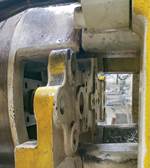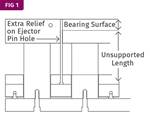Ejector Delay Unit for Two-Stage Demolding
Hasco’s Z1725/… ejector delay unit enables two-stage ejector demolding so sprue and part are cleanly separated through a coordinated ejector movement.
Hasco’s new Z1725/... ejector delay unit enables efficient demolding and separation of sprues via two-stage ejector demolding where the consistent delay is ensured by an individual pocket depth and the ejector assembly. Hasco says this enables the sprue and molded part to be cleanly separated from one another through a coordinated ejector movement.
Hasco says the new delay unit not only improves process reliability but also the quality of the end products. Production downtimes are reduced and maximum flexibility provided because the units can be used without any minimum stroke requirements. Ejector sizes from 2 to 5.9 mm enable a variety of applications in different production processes.
The ejector delay unit works by transferring axial forces through friction between the plastic sleeve and the drill-hole wall. This friction force can be adjusted by a conical, self-securing screw and adapted to the specific requirements. The plastic sleeve should sit approximately 3-mm deep in the location hole. The precise position of the ejector pin is secured by a flattened circular pocket. The desired delay is integrated into the pocket depth of the ejector package. The ejector delay can also be retrofitted into existing tools.

Hasco’s Z1725/… ejector delay unit enables two-stage ejector demolding. Source: Hasco
Related Content
-
Design Your Tools for Moldability ... and Maintenance
In the initial design phase, when considering the structure and elements of the tool, are you designing them to be maintenance friendly? Canon Virginia has used this approach and preventive maintenance to make tool replacement a thing of the past. You can, too. Here’s how.
-
Three Key Decisions for an Optimal Ejection System
When determining the best ejection option for a tool, molders must consider the ejector’s surface area, location and style.
-
How to Achieve Simulation Success, Part 2: Material Characterization
Depending on whether or not your chosen material is in the simulation database — and sometimes even if it is — analysts will have some important choices to make and factors to be aware of. Learn them here.



